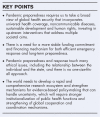Policy and planning for large epidemics and pandemics - challenges and lessons learned from COVID-19
- PMID: 34342301
- PMCID: PMC8452318
- DOI: 10.1097/QCO.0000000000000778
Policy and planning for large epidemics and pandemics - challenges and lessons learned from COVID-19
Abstract
Purpose of review: The COVID-19 pandemic is a global catastrophe that has led to untold suffering and death. Many previously identified policy challenges in planning for large epidemics and pandemics have been brought to the fore, and new ones have emerged. Here, we review key policy challenges and lessons learned from the COVID-19 pandemic in order to be better prepared for the future.
Recent findings: The most important challenges facing policymakers include financing outbreak preparedness and response in a complex political environment with limited resources, coordinating response efforts among a growing and diverse range of national and international actors, accurately assessing national outbreak preparedness, addressing the shortfall in the global health workforce, building surge capacity of both human and material resources, balancing investments in public health and curative services, building capacity for outbreak-related research and development, and reinforcing measures for infection prevention and control.
Summary: In recent years, numerous epidemics and pandemics have caused not only considerable loss of life, but billions of dollars of economic loss. The COVID-19 pandemic served as a wake-up call and led to the implementation of relevant policies and countermeasures. Nevertheless, many questions remain and much work to be done. Wise policies and approaches for outbreak control exist but will require the political will to implement them.
Copyright © 2021 The Author(s). Published by Wolters Kluwer Health, Inc.
Conflict of interest statement
Figures



References
-
- Jain V, Duse A, Bausch DG. Planning for large epidemics and pandemics: challenges from a policy perspective. Curr Opin Infect Dis 2018; 31:316–324. - PubMed
-
- UN Office of the High Commissioner. COVID-19 and its human rights dimensions; 2020. https://www.ohchr.org/EN/NewsEvents/Pages/COVID-19.aspx. [Accessed 29 July 2021]
-
- The Independent Panel. COVID-19: Make it the last pandemic 2021; https://theindependentpanel.org/. [Accessed 29 July 2021].
-
The Independent Panel was established by the World Health Organization (WHO) Director-General in response to the World Health Assembly resolution 73.1 to provide an assessment of the challenges ahead, based on insights and lessons learned from the health response to COVID-19
-
- Equity IoH. Build back fairer: the COVID-19 marmot review 2020; https://www.instituteofhealthequity.org/resources-reports/build-back-fai....
Publication types
MeSH terms
LinkOut - more resources
Full Text Sources
Medical
Research Materials
Miscellaneous

